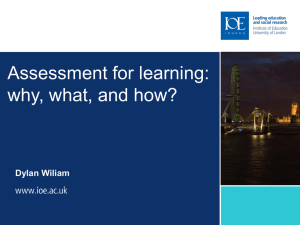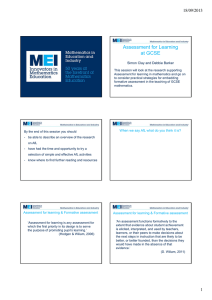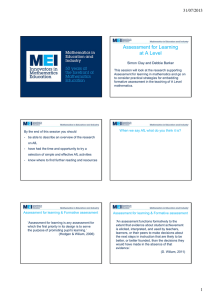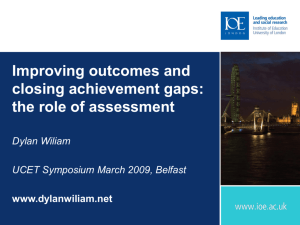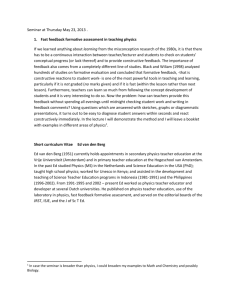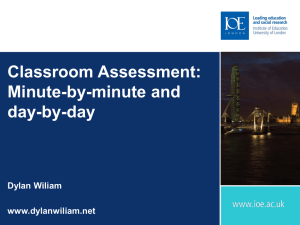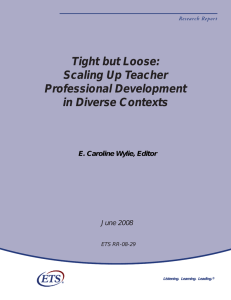Teachers
advertisement
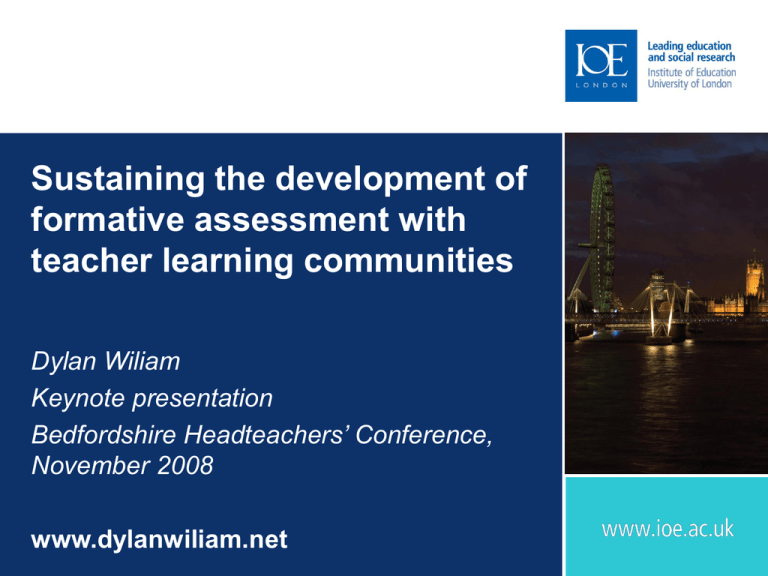
Sustaining the development of formative assessment with teacher learning communities Dylan Wiliam Keynote presentation Bedfordshire Headteachers’ Conference, November 2008 www.dylanwiliam.net Overview of presentation Why raising achievement is important Why investing in teachers is the answer Why formative assessment should be the focus Why teacher learning communities should be the mechanism How we can put this into practice Raising achievement matters For individuals Increased lifetime salary Improved health Longer life For society Lower criminal justice costs Lower health-care costs Increased economic growth …but what is learned matters too… Which of the following categories of skill is disappearing from the workplace most rapidly? 1. Routine manual 2. Non-routine manual 3. Routine cognitive 4. Complex communication 5. Expert thinking/problem-solving …but what is learned matters too… Autor, Levy & Murnane, 2003 …now more than ever… $35.00 $30.00 $25.00 Dropout $20.00 HS Diploma Some College BA/BSc $15.00 Prof Degree $10.00 $5.00 05 20 03 20 01 20 99 19 97 19 95 19 93 19 91 19 89 19 87 19 85 19 83 19 81 19 79 19 77 19 75 19 19 73 $0.00 Source: Economic Policy Institute Successful education… The test of successful education is not the amount of knowledge that a pupil takes away from school, but his appetite to know and his capacity to learn. If the school sends out children with the desire for knowledge and some idea how to acquire it, it will have done its work. Too many leave school with the appetite killed and the mind loaded with undigested lumps of information. The good schoolmaster is known by the number of valuable subjects which he declines to teach. (Sir Richard Livingstone, 1941) The only 21st century skill So the model that says learn while you’re at school, while you’re young, the skills that you will apply during your lifetime is no longer tenable. The skills that you can learn when you’re at school will not be applicable. They will be obsolete by the time you get into the workplace and need them, except for one skill. The one really competitive skill is the skill of being able to learn. It is the skill of being able not to give the right answer to questions about what you were taught in school, but to make the right response to situations that are outside the scope of what you were taught in school. We need to produce people who know how to act when they’re faced with situations for which they were not specifically prepared. (Papert, 1998) Where’s the solution? Structure Small secondary schools Larger secondary schools Alignment Curriculum reform Textbook replacement Governance Specialist schools Academies Technology Computers Interactive white-boards School effectiveness Three generations of school effectiveness research Raw results approaches Different schools get different results Conclusion: Schools make a difference Demographic-based approaches Demographic factors account for most of the variation Conclusion: Schools don’t make a difference Value-added approaches School-level differences in value-added are relatively small Classroom-level differences in value-added are large Conclusion: An effective school is a school full of effective classrooms Teacher quality matters… Barber & Mourshed, 2007 Teacher quality A labor force issue with 2 (non-exclusive) solutions Replace existing teachers with better ones? Important, but very slow, and of limited impact Teach First Gradually raising the bar for entry to teaching Improve the effectiveness of existing teachers The “love the one you’re with” strategy It can be done Provided we focus rigorously on the things that matter Even when they’re hard to do The ‘dark matter’ of teacher quality Teachers make a difference But what makes the difference in teachers? Advanced content matter knowledge Pedagogical content knowledge Further professional qualifications (MA, NBPTS) Total “explained” difference <5% 10-15% <5% 20-25% Cost/effect comparisons Intervention Extra months of learning per year Cost/yr Class-size reduction (by 30%) 4 £20k Increase teacher content knowledge from weak to strong 2 ? Formative assessment/ Assessment for learning 8 £2k The formative assessment hi-jack… Long-cycle Span: across units, terms Length: four weeks to one year Impact: Student monitoring; curriculum alignment Medium-cycle Span: within and between teaching units Length: one to four weeks Impact: Improved, student-involved, assessment; teacher cognition about learning Short-cycle Span: within and between lessons Length: day-by-day: 24 to 48 hours minute-by-minute: 5 seconds to 2 hours Impact: classroom practice; student engagement Unpacking formative assessment Key processes Establishing where the learners are in their learning Establishing where they are going Working out how to get there Participants Teachers Peers Learners Aspects of formative assessment Where the learner is going Teacher Peer Learner Where the learner is Engineering effective Clarify and share discussions, tasks and activities that elicit learning intentions evidence of learning How to get there Providing feedback that moves learners forward Understand and share learning intentions Activating students as learning resources for one another Understand learning intentions Activating students as owners of their own learning Five “key strategies”… Clarifying, understanding, and sharing learning intentions curriculum philosophy Engineering effective classroom discussions, tasks and activities that elicit evidence of learning classroom discourse, interactive whole-class teaching Providing feedback that moves learners forward feedback Activating students as learning resources for one another collaborative learning, reciprocal teaching, peer-assessment Activating students as owners of their own learning metacognition, motivation, interest, attribution, self-assessment (Wiliam & Thompson, 2007) …and one big idea Use evidence about learning to adapt teaching and learning to meet student needs Keeping Learning on Track (KLT) A pilot guides a plane or boat toward its destination by taking constant readings and making careful adjustments in response to wind, currents, weather, etc. A KLT teacher does the same: Plans a carefully chosen route ahead of time (in essence building the track) Takes readings along the way Changes course as conditions dictate Putting it into practice Implementing formative assessment requires changing teacher habits Teachers “know” most of this already So the problem is not a lack of knowledge It’s a lack of understanding what it means to do formative assessment That’s why telling teachers what to do doesn’t work Experience alone is not enough—if it were, then the most experienced teachers would be the best teachers—we know that’s not true (Hanushek, 2005; Day, 2006) People need to reflect on their experiences in systematic ways that build their accessible knowledge base, learn from mistakes, etc. (Bransford, Brown & Cocking, 1999) Teacher learning takes time To put new knowledge to work, to make it meaningful and accessible when you need it, requires practice. A teacher doesn’t come at this as a blank slate. Not only do teachers have their current habits and ways of teaching— they’ve lived inside the old culture of classrooms all their lives: every teacher started out as a student! New knowledge doesn’t just have to get learned and practiced, it has to go up against long-established, familiar, comfortable ways of doing things that may not be as effective, but fit within everyone’s expectations of how a classroom should work. It takes time and practice to undo old habits and become graceful at new ones. Thus… Professional development must be sustained over time Taking it to scale Two opposing factors in any school reform Need for flexibility to adapt to local conditions, resources, etc Implies there is appropriate flexibility built into the reform Need to maintain fidelity to core principles, or theory of action of the reform, if it is to achieve desired outcomes Implies you have a well-thought-out theory of action “Tight but loose” Some reforms are too loose (e.g., the ‘Effective schools’ movement) Others are too tight (e.g., Montessori Schools) The “tight but loose” formulation … combines an obsessive adherence to central design principles (the “tight” part) with accommodations to the needs, resources, constraints, and particularities that occur in any school or district (the “loose” part), but only where these do not conflict with the theory of action of the intervention. Teacher learning communities contradict teacher isolation reprofessionalize teaching by valuing teacher expertise deprivatize teaching so that teachers’ strengths and struggles become known offer a steady source of support for struggling teachers grow expertise by providing a regular space, time, and structure for that kind of systematic reflecting on practice facilitate sharing of untapped expertise residing in individual teachers build the collective knowledge base in a school How to set up a TLC Plan that the TLC will run for two years Identify 8 to 10 interested colleagues Should have similar assignments (e.g. early years, math/sci) Secure institutional support for: Monthly meetings (75 - 120 minutes each, inside or outside school time) Time between meetings (2 hrs per month in school time) Collaborative planning Peer observation Any necessary waivers from school policies Signature pedagogies In Law In Medicine A “signature pedagogy” for teacher learning? Every monthly TLC meeting should follows the same structure and sequence of activities Activity 1: Introduction & Housekeeping (5-10 minutes) Activity 2: How’s It Going (35-50 minutes) Activity 3: New Learning about formative assessment (20-45 minutes) Activity 4: Personal Action Planning (10 minutes) Activity 5: Summary of Learning (5 minutes) The TLC leader’s role To ensure the TLC meets regularly To ensure all needed materials are at meetings To ensure that each meeting is focused on AfL To create and maintain a productive and non-judgmental tone during meetings To ensure that every participant shares with regard to their implementation of AfL To encourage teachers to provide their colleagues with constructive and thoughtful feedback To encourage teachers to think about and discuss the implementation of new AfL learning and skills To ensure that every teacher has an action plan to guide their next steps But not to be the AfL “expert” Peer observation Run to the agenda of the observed, not the observer Observed teacher specifies focus of observation Observed teacher specifies what counts as evidence e.g., teacher wants to increase wait-time provides observer with a stop-watch to log wait-times The synergy Content: formative assessment Process: teacher learning communities Components of a model Initial workshops Monthly TLC meetings Peer observations ‘Drip-feed’ resources Writings New ideas Summary Raising achievement is important Raising achievement requires improving teacher quality Improving teacher quality requires teacher professional development To be effective, teacher professional development must address What teachers do in the classroom How teachers change what they do in the classroom Assessment for learning + Teacher learning communities A point of (uniquely?) high leverage A “Trojan Horse” into wider issues of pedagogy, psychology, and curriculum
